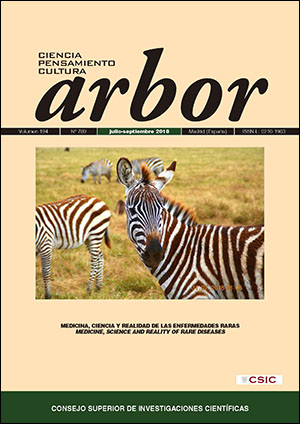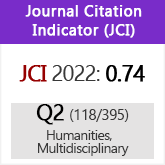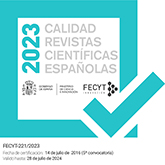La importancia de la cultura tecnológica en el movimiento maker
DOI:
https://doi.org/10.3989/arbor.2018.789n3013Palabras clave:
P2P, difusión social, apropiación social, STEM, cultura digital, movimiento maker, DIYResumen
La emergencia global del movimiento maker constituye uno de los fenómenos más recientes de difusión y apropiación de tecnologías por parte de la sociedad. El vencimiento de varias patentes en los campos de la fabricación digital y de la microelectrónica, junto con un reverdecimiento de la mentalidad DIY (Do It Yourself) y con la popularización de espacios, laboratorios y eventos temáticos por buena parte de la geografía internacional, han ayudado a consolidar una creciente presencia en la sociedad del enfoque conocido como aprender haciendo. En este artículo examinamos cómo ha surgido este movimiento e identificamos los principales valores que inspiran esta filosofía de capacitación de la ciudadanía a través de la tecnología. Así mismo analizamos las oportunidades que plantea este fenómeno para la promoción de una cultura tecnológica en la sociedad y también las contradicciones, mitos y retos que en él se encierran.
Descargas
Citas
A third industrial revolution (2012, 12 de abril). The Economist. [En línea]. Disponible en: http://www.economist. com/node/21552901
Anderson, C. (2012). Makers: the new industrial revolution. Random House.
Atkinson, P. (2006). Do It Yourself: Democracy and Design. Journal of Design History, 19 (1), pp. 1-10. https://doi.org/10.1093/jdh/epk001
Barbrook, R. y Cameron, A. (1996). The Californian ideology. Science as Culture, 6 (1), pp. 44-72. https://doi.org/10.1080/09505439609526455
Benkler, Y. (2006). The Wealth of Networks: How Social Production Transforms Markets and Freedom. New Haven and London: Yale University Press.
Birtchnell, T. y Urry, J. (2013). Fabricating Futures and the Movement of Objects. Mobilities, 8 (3), pp. 388-405. https://doi.org/10.1080/17450101.2012.745697
Chesbrough, H. (2003). Open innovation: The new imperative for creating and profiting from technology. Harvard, MA: Harvard Business Press.
Cruz, J., Herrington, S. y Rodríguez, B. (2014). Farmbot. [En línea]. Disponible en: http://digitalcommons.calpoly.edu/mesp/241
Dafermos, G. (2015). Transforming the productive base of the economy through the open design commons and distributed manufacturing. The Journal of Peer Production, 7. Disponible en: http://peerproduction. net/issues/issue-7-policies-for-the-commons/peer-reviewed-papers/ distributed-manufacturing/
Dafermos, G. y Söderberg, J. (2009). The hacker movement as a continuation of labour struggle. Capital & Class, 33 (1), pp. 53-73. https://doi.org/10.1177/030981680909700104
Dougherty, D. (2012). The Maker Movement. Innovations: Technology, Governance, Globalization, 7 (3), pp. 11-14. https://doi.org/10.1162/INOV_a_00135
Echeverría, J. (2008). El manual de Oslo y la innovación social. Arbor, 184 (732), pp. 609-618. Disponible en: http://arbor.revistas.csic.es/index.php/arbor/ article/viewArticle/210
Farrell, J. y Klemperer, P. (2007). Coordination and lock-in: Competition with switching costs and network effects. En: Handbook of Industrial Organization, vol. 3, pp. 1967-2072. https://doi.org/10.1016/S1573-448X(06)03031-7
Fox, S. (2014). Third Wave Do-It-Yourself (DIY): Potential for prosumption, innovation, and entrepreneurship by local populations in regions without industrial manufacturing infrastructure. Technology in Society, 39, pp. 18-30. https://doi.org/10.1016/j.techsoc.2014.07.001
García-Sáez, C. (2016). (Casi) Todo por hacer. Una mirada social y educativa sobre los Fab Labs y el movimiento maker. Madrid: Fundación Orange.
Gershenfeld, N. (2005). Fab: The coming revolution on your desktop - From personal computers to personal fabrication. New York: Basic Books.
Halverson, E. R. y Sheridan, K. (2014). The Maker Movement in Education. Harvard Educational Review, 84 (4), pp. 495-504. https://doi.org/10.17763/haer.84.4.34j1g68140382063
Haring, K. (2008). Ham Radio’s Technical Culture. Cambridge, Mass: The MIT Press.
Hatch, M. (2013). The maker movement manifesto: rules for innovation in the new world of crafters, hackers, and tinkerers. London: McGraw Hill.
Himanen, P. (2002). La ética del hacker y el espíritu de la era de la información. Barcelona: Destino.
Hippel, E. von (2005). Democratizing Innovation. Cambridge, MA: The MIT Press. Disponible en: http://web.mit.edu/evhippel/www/democ1.htm https://doi.org/10.7551/mitpress/2333.001.0001
Kneese, T., Rosenblat, A. y Boyd, D. (2014). Technologically Mediated Artisanal Production. Future of Work. Data & Society Working Paper. [En línea]. https://doi.org/10.2139/ssrn.2536613
Kostakis, V., Niaros, V., Dafermos, G. y Bauwens, M. (2015). Design global, manufacture local: Exploring the contours of an emerging productive model. Futures, 73, pp. 126-135. https://doi.org/10.1016/j.futures.2015.09.001
Kostakis, V. y Papachristou, M. (2014). Commons-based peer production and digital fabrication: The case of a RepRap-based, Lego-built 3D printing-milling machine. Telematics and Informatics, 31 (3), pp. 434-443. https://doi.org/10.1016/j.tele.2013.09.006
Kuznetsov, S. y Paulos, E. (2010). Rise of the Expert Amateur : DIY Projects, Communities, and Cultures. Proceedings of the 6th Nordic Conference on Human-Computer Interaction: Extending Boundaries. ACM, pp. 295-304. https://doi.org/10.1145/1868914.1868950
Leonard, A. (2013, 26 de julio). The Maker economy can't fix everything. [En línea]. Disponible en: http://www. salon.com/2013/07/26/the_maker_ economy_cant_fix_everything/
Lindtner, S. (2014). Hackerspaces and the Internet of Things in China: How makers are reinventing industrial production, innovation, and the self. China Information, 28, pp. 145-167. https://doi.org/10.1177/0920203X14529881
Lindtner, S. (2015). Hacking with Chinese Characteristics: The Promises of the Maker Movement against China's Manufacturing Culture. Science, Technology & Human Values, 40 (5), pp. 854-879. https://doi.org/10.1177/0162243915590861
Lindtner, S., Bardzell, S. y Bardzell, J. (2016). Reconstituting the Utopian Vision of Making. Proceedings of the 2016 CHI Conference on Human Factors in Computing Systems - CHI '16. ACM, pp. 1390-1402. https://doi.org/10.1145/2858036.2858506
Lindtner, S. y Li, D. (2012). Created in China: The Makings of China's Hackerspace Community. Interactions, 19, pp. 18-22. https://doi.org/10.1145/2377783.2377789
Lipson, H. y Kurman, M. (2010). Factory @ Home : The Emerging Economy of Personal Fabrication. [En línea]. Disponible en: http://citeseerx.ist.psu. edu/viewdoc/download?doi=10.1.1. 469.3463&rep=rep1&type=pdf
Locoro, A., Ravarini, A., Cabitza, F. y Mari, L. (2017). Is making the new knowing ? Tangible and intangible knowledge artifacts in DIDIY. En Proceedings of the 25th European Conference on Information Systems (ECIS) (Vol. 2017). Guimaraes: AIS Electronic Library (AISeL). Disponible en: https://aisel.aisnet.org/cgi/viewcontent.cgi?article=1018&context=ec is2017_rp
Martin, L. (2015). The Promise of the Maker Movement for Education. Journal of Pre-College Engineering Education Research (J-PEER), 5 (1). https://doi.org/10.7771/2157-9288.1099
Morozov, E. (2014, 23 de enero). Making It. The New Yorker. Disponible en: http://www.newyorker.com/magazine/2014/01/13/making-it-2
Mosterín, J. (1993). Filosofía de la cultura. Homo. Madrid: Alianza.
Mota, C. (2011). The Rise of Personal Fabrication. Proceedings of the 8th ACM conference on Creativity and cognition. ACM, pp. 279–288. https://doi.org/10.1145/2069618.2069665
Niaros, V., Kostakis, V. y Drechsler, W. (2017). Making (in) the Smart City: The Emergence of Makerspaces. Telematics and Informatics, 34 (7), pp. 1143-1152. https://doi.org/10.1016/j.tele.2017.05.004
Olivé, L. (2005). La cultura científica y tecnológica en el tránsito a la sociedad del conocimiento. Revista de la Educación Superior, XXXIV (4) (136), pp. 49-63. Disponible en: http://www. redalyc.org/html/604/60413604/
Perkel, D. (2006). Copy and paste literacy? Literacy practices in the production of a MySpace profile. En: Informal Learning and Digital Media: Constructions, Contexts, Consequences, pp. 21-23. Disponible en: http://people.ischool. berkeley.edu/~dperkel/writing/perkel_copypasteliteracyDRAFT_August2007.pdf
Quintanilla, M. Á. (1997). El concepto de progreso tecnológico. Arbor, CLVII (620), pp. 370-390. https://doi.org/10.3989/arbor.1997.i620.1822
Quintanilla, M. Á. (1998). Técnica y cultura. Teorema, XVII (3), pp. 49-69. Disponible en: http://www.oei.es/ salactsi/teorema03.htm
Quintanilla, M. Á. (2005). Tecnología: Un enfoque filosófico y otros ensayos de filosofía de la tecnología. Mexico D.F.: Fondo de Cultura Económica.
Ratto, M. y Ree, R. (2012). Materializing information: 3D printing and social change. First Monday, 17 (7), pp. 1-25. https://doi.org/10.5210/fm.v17i7.3968
Rheingold, H. (1996). La comunidad virtual: una sociedad sin fronteras. Gedisa.
Rogers, E. M. (1962). Diffusion of Innovations. New York: Free Press.
Sivek, S. C. (2011). "We Need a Showing of All Hands": Technological Utopianism in MAKE Magazine. Journal of Communication Inquiry, 35 (3), pp. 187-209. https://doi.org/10.1177/0196859911410317
Smith, A., Hielscher, S., Dickel, S., Söderberg, J. y Oost, E. van. (2013). Grassroots digital fabrication and makerspaces: reconfiguring, relocating and recalibrating innovation? SPRU-Science and Technology Policy Research No. 2013-02. [En línea]. Disponible en: https://www. ioew.de/fileadmin/user_upload/BILDER_und_Downloaddateien/Publikationen/2014/Smith_Hielscher_ Dickel_S%C3%B6derberg_Oost_- Grassroots.pdf
Tabarés-Gutiérrez, R. (2015, July 29). La Belleza del Código: Influencia de la Web 2.0, los medios sociales y los contenidos multimedia en el desarrollo de HTML5. [Tesis doctoral inédita]. Universidad de Salamanca: Salamanca. Disponible en: http://dsp.tecnalia. com/handle/11556/190
Tabarés-Gutiérrez, R. (2016). Approaching maker’s phenomenon. Interaction Design and Architecture(s), 30, pp. 19-29.
Tabarés-Gutiérrez, R., Bartolomé, T., Martelloni, L., Marmo, D., Amicis, L. de, Binenti, S. […] y Billy, L. (2018). Exploring the Emergent Open Manufacturing Industry - OPENMAKER White Paper v1.0. Disponible en: http://openmaker.eu/ wp-content/uploads/2018/02/D4.3- White-paper-version-1.0.pdf
Tabarés-Gutiérrez, R., Sopelana, A., García, J. y Moreno-Valdés, M. T. (2016). Social Manufacturing: Towards the popularization of personalized fabrication. Science and Technology by Other Means – Exploring collectives, spaces and futures EASST / 4S 2016. Barcelona. Disponible en: https:// www.researchgate.net/publication/311739460_Social_Manufacturing_Towards_the_popularization_ of_personalized_fabrication
Toboso-Martín, M. (2014). Perspectiva axiológica en la apropiación social de tecnologías. Revista Iberoamericana de Ciencia, Tecnología Y Sociedad, 9(25), 1–18.
Wenger, E. (1999). Communities of practice: Learning, meaning, and identity. Cambridge University Press.
Publicado
Cómo citar
Número
Sección
Licencia
Derechos de autor 2018 Consejo Superior de Investigaciones Científicas (CSIC)

Esta obra está bajo una licencia internacional Creative Commons Atribución 4.0.
© CSIC. Los originales publicados en las ediciones impresa y electrónica de esta Revista son propiedad del Consejo Superior de Investigaciones Científicas, siendo necesario citar la procedencia en cualquier reproducción parcial o total.Salvo indicación contraria, todos los contenidos de la edición electrónica se distribuyen bajo una licencia de uso y distribución “Creative Commons Reconocimiento 4.0 Internacional ” (CC BY 4.0). Puede consultar desde aquí la versión informativa y el texto legal de la licencia. Esta circunstancia ha de hacerse constar expresamente de esta forma cuando sea necesario.
No se autoriza el depósito en repositorios, páginas web personales o similares de cualquier otra versión distinta a la publicada por el editor.















